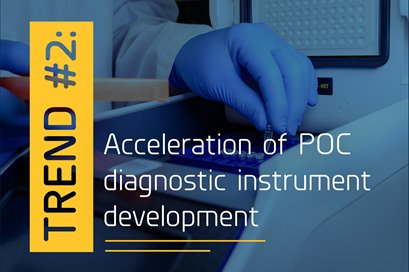As we close in on the end of any year, it’s natural to look ahead and ask what the medical device industry outlook appears to be from here. This year, that may be especially true. In the wake of the COVID-19 pandemic, we’ve seen changes, disruptions—even some advances in healthcare and life sciences product development—like we’ve rarely seen before.
What can developers, creators, and manufacturers of healthcare and life science technologies look forward to as we enter a new phase of the world’s response to and recovery from the global pandemic? We asked our Healthcare and Life Sciences team about some of the top concerns, challenges, changes and opportunities they’re hearing from manufacturers of medical devices and life science instrumentation coming out of 2021. Not predictions or prognostications, but medical device industry trends that we will all do well to keep an eye on.
Here are four possible medical device market trends we’re paying attention to.
Medical Device Trend #1: The continuation of global supply chain challenges
Rachel Matthews, Senior Director, Customer Management
 It should come as no surprise that global supply chain shortages top the list. The global semiconductor shortage is affecting nearly every industry. Some have called the state of the supply chain “chipageddon” or a “chipocalypse”—and that’s not an overstatement. Many experts believe that catching up to the backlog of demand is likely to take us through 2022 and into 2023.
It should come as no surprise that global supply chain shortages top the list. The global semiconductor shortage is affecting nearly every industry. Some have called the state of the supply chain “chipageddon” or a “chipocalypse”—and that’s not an overstatement. Many experts believe that catching up to the backlog of demand is likely to take us through 2022 and into 2023.
Like all the rest, the medical device supply chain is facing these same challenges. And it goes even beyond semiconductors—raw materials and commodities across the board are experiencing greatly extended lead times, and part and material shortages. For many medical device manufacturers, this is more than a disruption. Some are looking at taking a major financial hit—at best. Many are recognizing this as a threat to their very survival as a business.
In this environment, proactive supply chain solutions will be a top priority for medical device manufacturers. Planning around severely extended lead times, identifying replacement parts, even redesigning to accommodate for supply availability—all of this requires better visibility and agility. It’s critical to be able to quickly identify what parts are at greatest risk and pivot where possible to secure the necessary supply to get much-needed healthcare products to market.
If a single part isn’t available for a life-saving medical device, the product can’t ship—and, simply put, it won’t be there for those whose lives may depend on it. That’s a result that absolutely cannot be an acceptable solution for any of us. Thinking about supply chain from the earliest moments, leveraging predictive analytics, and relying on the relationships of a dependable, global supply chain partner will be some of the most important decisions healthcare and life sciences OEMs make.
Medical Device Trend #2: Acceleration and evolution of point-of-care diagnostic devices
Bill Fitzgerald, Director of Life Sciences
 Especially for diagnostic instruments, the COVID-19 pandemic has pushed us into newer territories, faster. Two life sciences technology trends have come out of this: an acceleration of and progression beyond standard point-of-care diagnostic instrument development. Life sciences companies are asking, “How can we get more types of testing and results out to where they’ll be needed most?” And, “How can we do it faster?”
Especially for diagnostic instruments, the COVID-19 pandemic has pushed us into newer territories, faster. Two life sciences technology trends have come out of this: an acceleration of and progression beyond standard point-of-care diagnostic instrument development. Life sciences companies are asking, “How can we get more types of testing and results out to where they’ll be needed most?” And, “How can we do it faster?”
The pandemic put massive pressure on manufacturers of point-of-care testing devices to not only increase production, but to accelerate the entire product development process. That’s the kind of pressure cooker where innovations often become new standards. Speed to market is always important. But when it became even more critical to quickly respond to the rapid spread of COVID-19, manufacturers of diagnostic equipment had to find new ways to accelerate design, development and testing. Those leaps forward in life science instrument development aren’t likely to slow down significantly. Essentially, now that we know it can be done, it’s unlikely we’ll think the same way we used to about the speed of development or the speed of returning results going forward.
That means life science companies need partners who understand the time-to-market pressure, complexities and requirements of diagnostic instrument development for this new reality. And those partners need to be able to plug in how, where and when they’re needed—complementing the OEM’s own team with the resources and expertise they don’t, or perhaps couldn’t, have in-house. The life science companies who are prepared to offer that kind of rapidly developed, rapid-response technology at the point of use are the ones who will be better positioned to handle the next global health crisis.
Medical Device Trend #3: The rebound of elective procedures (and the medical devices and equipment needed for them)
Mike Tendick, VP, Healthcare and Life Sciences Market Sector
 During the COVID-19 pandemic, elective surgeries were put on hold. Along with them, demand for the medical equipment used in those procedures declined. Now those elective procedures are starting to ramp up again, and many procedure-dependent medtech companies have reported better-than-expected sales growth as a result of a rebound in nonessential procedures.
During the COVID-19 pandemic, elective surgeries were put on hold. Along with them, demand for the medical equipment used in those procedures declined. Now those elective procedures are starting to ramp up again, and many procedure-dependent medtech companies have reported better-than-expected sales growth as a result of a rebound in nonessential procedures.
For medical device manufacturers, this means ramping back up to meet returning demand for medical equipment—like robotic-assisted surgery systems, for instance. This is good news—but it also presents some challenges. There’s the impact of a tight global supply chain. Capacity can be a challenge as well—simply having the space or the people hours to scale up production effectively.
For many medical device manufacturers, that means an increased need for outside resources to manage some of the manufacturing load. It will be key to work with partners who can extend your own capabilities. That could mean ensuring manufacturability with design for manufacturing, building and managing supply chain, adding the manufacturing capacity to increase production—or all of the above.
Of course, on the other side of returning to higher levels of production comes the ability to ramp up innovation. Many medical device manufacturers plan to increase R&D spending over the coming year. As new product development activities increase, outsourcing engineering, test development, prototyping and other product development services may become necessary, as well.
Medical Device Trend #4: Continued integration of artificial intelligence (AI), machine learning and internet of things (IoT) … and the medical device cybersecurity that goes with it
Jenna Joestgen, Director of Engineering Solutions, Healthcare
 According to a report by Grand View Research, the market size for AI in healthcare is expected to grow from $10.4 billion in 2021 to $120.2 billion by 2028. A significant driver of the expansion belongs to medical technologies like diagnostics and robotic-assisted surgery. There’s great opportunity for those who are able to figure out effective ways to integrate advanced computing and connectivity into their existing or upcoming portfolio of healthcare and life sciences products.
According to a report by Grand View Research, the market size for AI in healthcare is expected to grow from $10.4 billion in 2021 to $120.2 billion by 2028. A significant driver of the expansion belongs to medical technologies like diagnostics and robotic-assisted surgery. There’s great opportunity for those who are able to figure out effective ways to integrate advanced computing and connectivity into their existing or upcoming portfolio of healthcare and life sciences products.
Even if you’re not looking to integrate AI into current products, this is a medical device trend that will be critical to pay attention to. Leveraging methods like machine learning can accelerate the product development process. And fortune favors the prepared. The better a manufacturer is prepared to jump in when the time is right—including understanding evolving regulations—the better they’ll be positioned for success in an increasingly digital landscape.
Of course, with all of those technologies comes the increased importance of cybersecurity for medical devices. And there are two sides to the issue of cybersecurity. First, the product development and manufacturing side—how a partner controls and protects the customer’s information. Then there’s the security of connected products against cyber threats when they’re in use out in the market. Healthcare OEMs will need to make sure that they’re working with partners who not only understand, but are proactively prepared for the cybersecurity needs of today’s medical device industry.
It’s worth noting that it’s not only new, more advanced equipment that’s at risk. Cybersecurity can be an even bigger challenge for legacy products already in the field. Every medical device that can be accessed digitally needs to make security a priority. Because it’s not just about protecting data—in the end we’re protecting the people whose lives depend on the devices we make.
Are you prepared for these medical device industry trends?
There’s plenty to look forward to in the healthcare and life sciences market. Yes, there will be more challenges to navigate. But there’s opportunity on the horizon.
No matter the medical device trends you’re most focused on, one key to success will be to build strong partnerships to help capitalize on them. Smart outsourcing—whether it’s in the early design and development phases, manufacturing, or support after your products hit the market—can add the expertise, capabilities and capacity to move faster and enter the market more competitively.
If you’re not sure what that kind of partnership could look like, reach out to the Plexus team. We have decades of experience helping market leaders design, manufacture and support complex healthcare and life science products. And we can help you determine the best way forward to bring your innovation to the customers—and the patients—who are counting on what you’ll create.